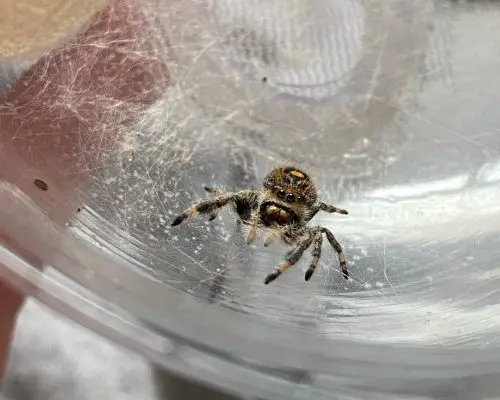Buying a Jumping Spider
Deciding to buy pet jumping spiders should not be a spontaneous choice, but it is also a decision that you are very unlikely to regret. These cute, eight-legged creatures make great pets for just about anyone, and they have even started to help people overcome their fear of spiders – arachnophobia. In fact, it is this phobia that has caused an increase in the number of people buying a jumping spider for themselves.
Despite the popularity of keeping a jumping spider as a pet, you might still be wondering if you specifically can have one. Jumping spiders are tiny pets; you don’t have to worry about walking them like you would a dog or brushing them like you might a cat. Depending on the species, they can be relatively simple to care for, too.
So, for those of you looking for more information before buying a pet jumping spider, we have created a complete guide so you can make the most informed decision.
Which Jumping Spider Species is Best for a Beginner?
As a beginner in the jumping spider-keeping community, you should be aware of the traits and needs of each spider species. This is essential in understanding how to take care of a jumping spider. It can also help you decide whether or not that particular spider is the right choice for you.
If you have kept other exotic pets, such as tarantulas, snakes, and/or lizards, then you are more likely to understand how to meet the needs these spiders have, such as the humidity levels and temperature inside the enclosure. However, if you haven’t kept pets of this nature before and you are a first-time spider owner, don’t be disheartened; there are a lot of resources to help you learn.
Below are some of the most commonly kept jumping spiders:
Bold Jumping Spider - Phidippus Audax
In North America, the bold jumping spider is one of the most popular species to be kept as a pet. The “Audax” in their scientific name is derived from Latin, meaning “daring, audacious”, so these spiders are aptly named as they are well-known for hunting down prey larger than themselves.
Bold spiders are black and roughly medium in size when compared to regals, zebras, and other jumping spiders; females measure between 8 to 19 millimeters, and males measure between 6 to 13 millimeters. They are rather hardy, living happily at room temperature with a daily misting to aid humidity. For more on the natural habitat of the Phidippus Audax spiders, click here.
Regal Jumping Spider - Phidippus Regius
Regal jumping spiders are the largest species of jumping spider found in North America; sizing ranges between 6 and 22 millimeters, with females usually being bigger than the males. They come in color and pattern variations, depending on the locale of each spider, but can end up being bright tones of orange.
However, keeping a regal jumping spider means you will have to provide heat if your home’s temperature isn’t consistently between 24 to 28 Celsius, as they are slightly more fragile than others in the Salticidae family. You will also need to keep an eye on controlling the right humidity level as well, which should be around 50 to 60 percent.
Other Species
There are a few other species that can be kept as pet jumping spiders.
Tan Jumping Spider - Platycryptus Undatus
Tan jumping spiders, although yet to be successfully bred in captivity, are relatively docile. Even though they are one of the smaller spiders, they are simple to catch.
Zebra Jumping Spider - Salticus Scenicus
The zebra jumping spider is one of the smallest, meaning they can be difficult to catch and interact with. They are commonly found basking in a sunny location; fence posts, window sills, and sidewalks are popular places for the zebra species.
How Do You Find a Reputable Breeder of Jumping Spiders?
When you have researched the species you wish to keep, you can then begin the process of buying a pet jumping spider. It is suggested that you find a reputable breeder, either to provide advice or to buy a captive-bred jumping spider from.
Breeders are a great way to get some of your questions answered. The more experienced breeders will have a wealth of knowledge to share, and they are usually more than happy to educate beginners. They can advise beginners on the species that would best suit you and your home, the correct enclosure set-up to provide adequate space for the spider to jump and climb around, the feeding method and the best feeder insects, and more.
But how do you find a reputable breeder of captive-bred jumping spiders? That is the big question! Luckily, two main options are available to you, as outlined below.
Online
Finding a jumping spider breeder online is relatively easy, especially as the market for jumping spiders has become increasingly popular. A quick Google search brings up lots of results; however, it is the number of results that can cause a bit of difficulty in finding a truly reputable breeder.
You should aim to find someone who is experienced in breeding and keeping jumping spiders.
Although it may sound slightly odd, many jumping spiders are sold online and then sent via post. In most cases, the jumping spiders are sent in small, ventilated tubs with paper towel to create webs in and food to eat during the journey.
Most breeders online will only post spiders out to their new owners when the temperature and weather are suitable. Wintertime is usually too cold for spiders to survive, even with heat packs, so shipping may be delayed until there is warmer weather. You should be wary of a breeder who is willing to ship a young spider when the temperature is low, as they might not have the spider’s best interests at heart.
Facebook Groups
Instead of just using the search function online, you can use Facebook groups to find trustworthy breeders of jumping spiders; this is especially helpful if you are buying a jumping spider for the first time. There are plenty of groups; some are dedicated to certain species while others focus more on the users’ locations.
For most groups, there are rules against posting spiders for sale, but this doesn’t mean you won’t find any. Breeders will upload images of their spiders, updates on the eggs they currently have, and so on. Many of them post these as “shares” from their own business or personal pages, so it is easy to get in touch with them.
And, if the breeder you contact doesn’t have any spiders available at that moment, they might give you details of another breeder they recommend. The community is very close-knit, with breeders loaning out male jumping spiders to each other to ensure new lines are born regularly.
Here are some of the Facebook groups recommended for jumping spider owners:
Exotic Pet Store
If you are lucky enough to live near a store selling exotic pets, then you can use this as a resource for finding an ethical spider breeder.
You might be very lucky and find that the store sells jumping spiders; do your research and ensure the store can provide all the essential information on the spider if this is the case. Just like the breeder, the store should be able to tell you the species, the date the spider left the nest, what instar the spider is (how many times the spider has molted), etc.
But it is suggested that you visit these pet shops in person, instead of just buying from them online. This allows you the opportunity to see the environment the spiders have lived in, if they have received good quality care, and if the store workers are knowledgeable on the species of spiders being sold.
Can You Keep a Wild-Caught Jumping Spider?
Throughout the United States, jumping spiders are quite common, in rural and urban areas, but especially in warmer weather. This means that catching a wild spider is a definite possibility for some people. It is sometimes the preferred option for people as it’s free, and there’s less ecological impact.
But it has been found that most wild-caught spiders can be less docile and difficult to handle, in comparison to those that have been bred in captivity.
Risks of Keeping Wild-Caught Jumping Spiders
Although catching a wild spider is the cheaper option when obtaining a pet jumping spider, it can cause some problems.
Gravid Females
One of the risks of keeping a jumping spider you’ve found in the wild is the possibility of catching a gravid female. This means a mature female jumping spider that is carrying fertile eggs. A single female spider is capable of producing up to seven clutches of eggs from one mating.
Each egg sac can eventually hatch to produce tens or hundreds of spiderlings, which you can release into the wild if the temperature is suitable. Being much smaller than adult jumping spiders, spiderlings can easily escape the enclosure through ventilation holes, gaps created by the door, and such, so it is worth remembering this if you do intend to keep wild-caught or intend to breed captive-bred spiders. After all, it is a significant concern that the baby spiders will end up running loose in your house.
Spiderlings also require smaller food due to their size; this can range from teeny fruit flies to mini mealworms. It will take time before they can be given the same green and bluebottle flies that mature spiders can easily eat.
Unknown Age
Choosing to keep a wild-caught spider also means you are unaware of how old the spider is. As a jumping spider has a relatively short lifespan, catching a spider in the wild might mean you have an older adult; this means less time bonding with and enjoying your new pet.

